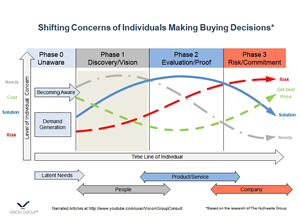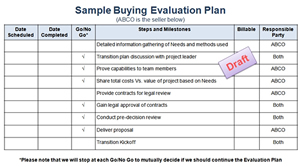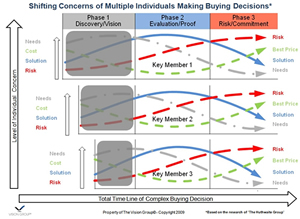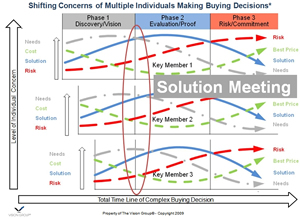Gain Trust of the Buying Committee With a Formal Buying Evaluation Plan - Part 2
“Walking in to meet with the buying committee I had two primary objectives. Confirm the findings of the discovery process, (including needs, value, solution, and reasons preventing the buying organization from achieving needs), and to gain agreement to move into an active buying evaluation, with a mutually negotiated and written plan." Here is part 2 of Dan Lemke’s story.

As key buying committee members entered the conference room I introduced myself and placed a face with the names I had talked to previously. This was the first time I had physically met with the 10 people around the table. As discussed in part 1, during the previous week I had spoken with the members by phone going through a discovery process, (Phase I in the diagram).
Our phone conversations had been one-on-one and focused on their individual needs, current situation, potential capabilities of my offering and value. (As an aside, when I contacted each key buying committee member via email with an agenda, I also attached a short biography on myself with a picture).
All of the conversations had been documented to each member I talked to. I asked each of them to share their approved version of the letter with other planned attendees to the “Solution Meeting”. Asking each buyer to share an approved letter demonstrates a number of things to the buyers and to me.
- The committee member had enough trust in our discussion to share it with others.
- It demonstrated to me that they agreed to some extent with the letter and its content.
- Knowing that the content of the letters focused on business needs, issues, capabilities and value, versus a self serving letter about me and my company, I had done the best I could to help these key buyers conclude that I was there to be part of their solution.
Looking at the diagram, I was trying to practice what I preach, which is sense where the individual is in their timeline and focus on their needs. Based on the phone calls, I was in early with this opportunity. The individuals I interviewed were in various phases of discovery (phase 1). Their needs were the most important concern during our conversations.
Also note in phase I, the focus of an individual is on the people who can help them, not the product or company. During the discovery phase, individuals are interested in how we can help them achieve their needs. They will discount the value of a sales person if they don't conclude the sales person can help them. Product details should be the last thing to leave our lips when we are in early.
The meeting agenda included introductions, objectives of the meeting and a brief review of needs, issues, capabilities, and value that I discovered. This allows me to ask if the information in my correspondence is still representative of the current situation.
By asking this question, I can listen very carefully to what they say and do. An affirmative answer indicates the capabilities I will be discussing are appropriate. I am never surprised if the needs have evolved since I wrote the correspondence.
The evolution of the truth is important for the winning sales person to sense and be aware of. If the buyers demonstrate evolved needs it may mean they have been thinking about my solution, have been talking to others (competitors, peers, trusted others) or among themselves. The key to my success is to check in as the sell/buy cycle proceeds.
Looking at the diagram below, after this Solution Meeting is wrapping up, the majority of the needs are on the table. The buying committee is forming a common Vision of a Solution to resolve their individual needs during the meeting. They are also able to observe how the needs of each functional area require different capabilities to solve the most needs of the overall business. Which can, and should lead to delivering superior value for the project and the buyers.
Based on the comments during the meeting, the capabilities offered appeared to provide sufficient value. So we are nearing the end of phase 1 and potentially beginning to enter phase 2, the formal evaluation phase. A reasonable and logical question I can ask,
“At this point, I am done with providing feedback to you as a group regarding the interviews and potential capabilities that may help. As a group would you like to continue to evaluate these capabilities with The Vision Group?”
Providing the answer is yes, my next question is,
“What else would you need to know to make a yes or no business decision to work with my organization?”
I am prepared at this point to write down anything the customer says. It is not the right time to say, “no” or “disagree” with what they suggest. These are their requests, so, document them and determine how best to respond to anything you may not do at a later time.
 After gathering their input, I present a draft of a buying evaluation plan I have used with previous customers. Covering any points they did not bring up in their request, which may be required on my end, or have not been considered up to this point.
After gathering their input, I present a draft of a buying evaluation plan I have used with previous customers. Covering any points they did not bring up in their request, which may be required on my end, or have not been considered up to this point.
A draft buying evaluation plan also allows me to cover timing of a potential project and when the customer wants to achieve the value discovered. It goes without saying, if the value is low, so will be the priorities of transitioning to any new capabilities.
At this point the meeting is ending and my next step is to prepare and submit back to them a "DRAFT" buying evaluation plan for review and comment, so we can arrive at a mutually agreeable plan. Once the buying evaluation plan is in place, we begin to execute the various steps leading up to the final buying decision.
Unfortunately, I have run out of time and will cover, First Gain Trust Then Manage the Evaluation Plan next month.
Our clients tell us to become proficient at consultative selling it is not enough to ask good questions and listen. We also need to stay aligned with our buyers shifting concerns as they are making buying decisions and demonstrate behaviorally correct skills throughout the buy sell cycle.
Building Trust and The Best Buying Experience in B2B is a series of articles being written by the Vision Group.
- Discovering needs before we meet with the buying committee helps gain trust- part 1.
- Helping create a Vision of a Solution moves the buying committee into the evaluation phase - part 2.


